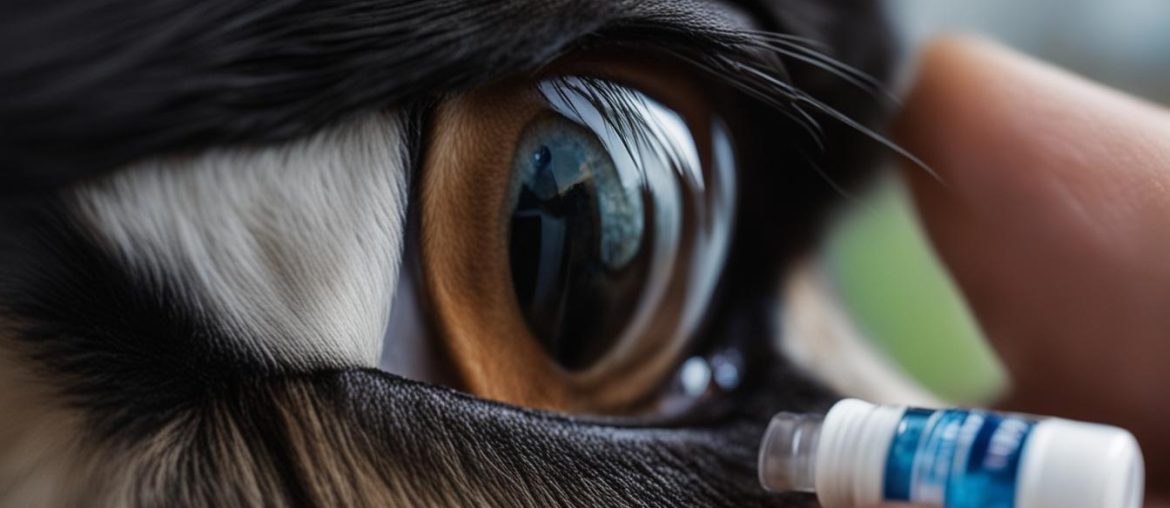As a responsible pet owner, you may be wondering if it’s safe to use human eye drops on your furry friend. While it may seem convenient to reach for the nearest bottle of eye drops, it’s important to understand that dogs have different eye care needs than humans. Using the wrong eye drops can potentially harm your dog’s delicate eyes and exacerbate their eye problems.
When it comes to treating eye issues in dogs, it’s always best to consult with a veterinarian. Veterinarians are trained to diagnose and provide appropriate treatment for eye conditions in dogs. They can accurately determine the underlying cause of the problem and prescribe the right medications for your pet. What works for humans may not have the same effect on dogs, and some human eye drops can even cause major damage to their eyes.
Key Takeaways:
- Using human eye drops on dogs can be dangerous and may cause major damage to their eyes.
- Veterinarians must examine and diagnose eye problems in dogs, and medications that work on humans may not have the same effect on dogs.
- Dog eye infections are common and require proper treatment.
- Good eye care with dog tear stain removers and eye wipes can help prevent eye problems.
Can Dogs Use Human Eye Drops for Allergies?
Dogs, just like humans, can experience allergies that affect their eyes. However, it is important to note that human eye drops should never be used on dogs without consulting a veterinarian. Human eye drops, such as Visine, are not safe for canine use and can cause permanent damage to their eyes. Similarly, other human antihistamine eye ointments should be avoided when treating dogs with allergies.
Allergies in dogs are best treated by identifying and removing the source of the allergy from their environment. This may include changing their diet, using hypoallergenic pet products, or modifying their living space. Consulting a veterinarian is crucial in determining the appropriate treatment plan for your dog’s allergies, which may include safe and effective eye drop options specifically designed for dogs.
Table: Comparison of Human Eye Drops and Dog-Specific Allergy Eye Drops
| Aspect | Human Eye Drops | Dog-Specific Allergy Eye Drops |
|---|---|---|
| Use on Dogs | Not Safe | Safe and Effective |
| Potential Eye Damage | May Cause Permanent Damage | No Known Harmful Effects |
| Allergy Treatment | Not Recommended | Specifically Formulated for Dogs |
| Consulting a Veterinarian | Recommended | Essential for Proper Treatment |
The table above highlights the key differences between using human eye drops and dog-specific allergy eye drops for treating allergies in dogs. It is crucial to prioritize your dog’s safety and consult with a veterinarian to ensure the appropriate treatment is administered. Proper diagnosis and professional guidance will help address your dog’s allergies effectively, providing them with the relief they need.
Can You Use Human Antibiotic Eye Drops for Dogs?
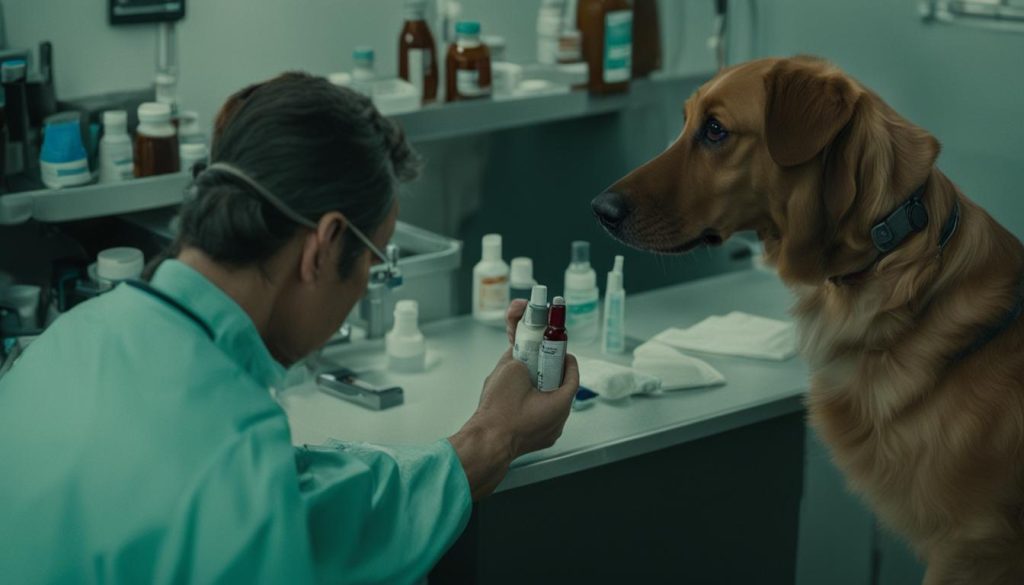
When it comes to treating eye infections in dogs, using human antibiotic eye drops may seem like a convenient solution. However, it is important to exercise caution and consult a veterinarian before administering any medication to your furry friend.
Human eye drops are specifically formulated for the human eye and may not have the desired effect on dogs. In fact, using the wrong antibiotic eye drop or the wrong dosage can lead to antibiotic resistance, making future infections harder to treat. Additionally, the type of bacterial infection your dog has may be different from those commonly seen in humans. Therefore, it is crucial to have a proper diagnosis from a veterinarian to ensure the most effective treatment.
For dry eyes in dogs, human antibiotic eye drops are not recommended. Dry eyes in dogs may have various causes, such as allergies, environmental factors, or underlying health conditions. It is best to consult a veterinarian who can recommend specialized eye drops that are safe and effective for treating your dog’s specific condition.
Key Points: |
|---|
|
When it comes to your dog’s eye health, it is always best to err on the side of caution and seek professional advice. Your veterinarian can provide the necessary guidance and recommend the most appropriate treatment for your dog’s specific condition. Remember, your pet’s well-being should always be a top priority.
Can You Give Your Dog Human Steroid Eye Drops?
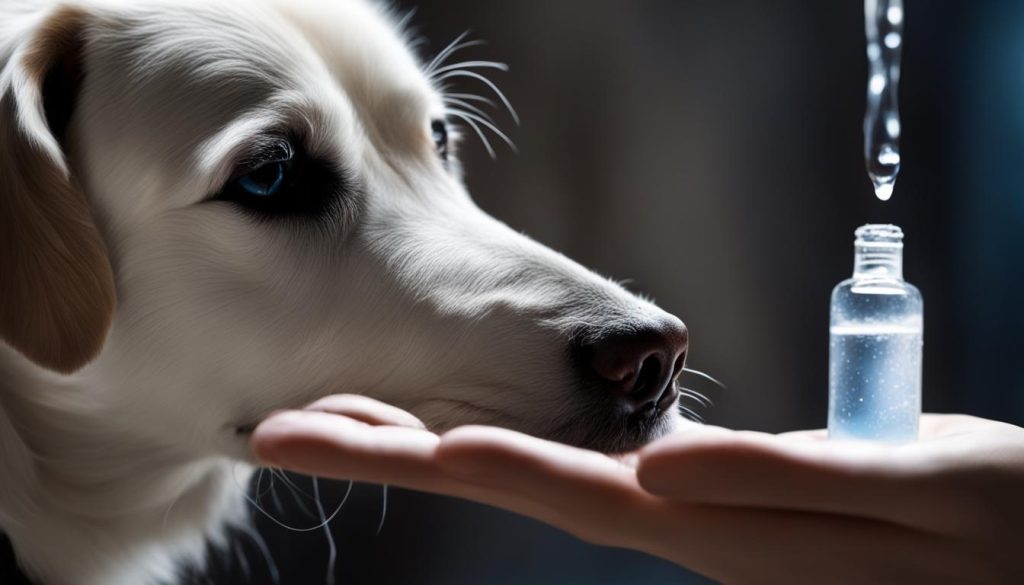
When it comes to treating inflammation in your dog’s eyes, veterinarians may prescribe corticosteroids or steroid eye drops. These medications can be effective in reducing swelling and discomfort. However, it is important to remember that not all human steroid eye drops are safe for dogs. Using human versions of these eye drops without consulting a vet can potentially delay healing and pose risks to your dog’s eye health.
Human steroid eye drops may contain different concentrations or types of steroids than those formulated for dogs. Plus, the dosing instructions for human eye drops may not be appropriate for canine use. Only a veterinarian can determine the correct dosage and frequency of administration based on your dog’s specific condition.
When it comes to your dog’s eye health, always consult with a veterinarian before using any medication, including human eye drops. Your vet will perform a thorough examination and recommend the most suitable eye drops for your dog’s needs. Following their guidance will ensure the best possible outcome and help to maintain your furry friend’s visual well-being.
Risks of Using Human Steroid Eye Drops on Dogs
Using human steroid eye drops on dogs can pose various risks:
- Delayed healing: Improper use of steroid eye drops can hinder the healing process and prolong your dog’s recovery
- Increased risk of infection: Steroids can suppress the immune response, making your dog more susceptible to eye infections
- Side effects: Dogs may experience side effects such as increased thirst, increased appetite, or changes in behavior when given human steroid eye drops
Always prioritize your dog’s health and work closely with a veterinarian to ensure safe and effective treatment for any eye-related issues.
| Risks of Using Human Steroid Eye Drops on Dogs | Precautions |
|---|---|
| Delayed healing | Consult a veterinarian for appropriate steroid eye drops formulated for dogs |
| Increased risk of infection | Follow the vet’s instructions for dosage and duration of treatment |
| Side effects | Monitor your dog closely for any changes in behavior or appetite |
Can You Use Human Lubricating Eye Drops for Dogs?

When it comes to treating dry eyes in dogs, many pet owners wonder if they can use human lubricating eye drops. While some human eye drops may be safe for dogs with temporary dry eye problems, it is crucial to exercise caution and consult with a veterinarian before administering any medication to your furry friend.
Human lubricating eye drops are designed for the specific needs of human eyes, and their safety and effectiveness on dogs have not been extensively studied. Dogs have different eye structures and tear composition, which means that what works for humans may not work the same way for our canine companions.
To ensure your dog’s eye health and safety, it is always best to seek professional advice from a veterinarian. A thorough examination by a vet will help determine the underlying cause of your dog’s dry eyes and the most appropriate course of treatment. They may recommend specific eye drops formulated for dogs or provide alternative solutions to alleviate your pet’s dry eye symptoms.
- Human lubricating eye drops may not be safe or effective for dogs with dry eye problems.
- Consult with a veterinarian to determine the cause of your dog’s dry eyes and the best treatment options.
- Avoid using human eye drops on your dog without professional guidance.
- Follow your vet’s recommendations for treating your dog’s dry eyes and maintaining their overall eye health.
Can You Use Human Saline Eye Drops on Dogs?
When it comes to eye care for our furry friends, we often wonder if we can use the same products that we use on ourselves. One common question that pet owners have is whether human saline eye drops can be used on dogs. Let’s take a closer look at this topic to better understand what is safe and appropriate for our canine companions.
Using human saline eye drops on dogs can be a safe and effective way to clean their eyes or flush out any foreign particles. Saline eye drops are a sterile solution that contains salt and water. They can help remove debris, soothe irritation, and provide temporary relief for mild eye discomfort in dogs. However, it is important to choose a saline eye wash specifically designed for dogs or make your own saline wash at home to ensure it is safe for use.
“If your dog has a little discharge or needs their eyes rinsed, you can use over-the-counter saline human wash. However, it is important to choose a sterile eye wash specifically designed for dogs or make your own saline wash at home. Always check with a vet before using any eye drops or washes on your dog.”
Consulting with a veterinarian is crucial before using any eye drops or washes on your dog. They can provide guidance on the appropriate saline eye drops to use and advise on any additional treatment that may be necessary for your dog’s specific eye condition. Remember, your pet’s health and well-being should always be your top priority, and seeking professional advice is the best way to ensure their safety.
Can I Give My Dog Human Eye Drops for Conjunctivitis?
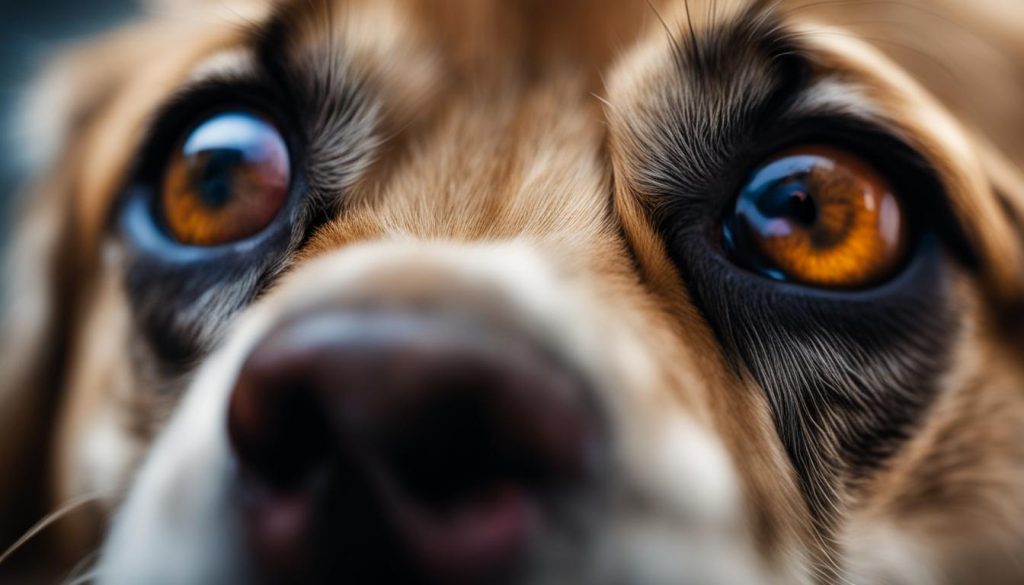
When it comes to treating conjunctivitis in dogs, it is important to exercise caution and follow the guidance of a veterinarian. While some human eye drops may be effective in treating conjunctivitis in humans, it does not mean they are safe or suitable for dogs.
Using human eye drops on dogs can pose potential risks and may not provide the desired outcome. Dogs have different eye structures and sensitivities compared to humans, and their eye conditions require specific medications tailored for their needs.
To ensure the well-being of your furry friend, it is crucial to consult with a veterinarian before administering any eye drops. A veterinarian will be able to diagnose the underlying cause of the conjunctivitis and prescribe appropriate treatment, which may include specialized eye drops specifically formulated for dogs.
Common Eye Conditions in Dogs
- Conjunctivitis
- Keratoconjunctivitis
- Corneal ulcers
- Dry eyes
These conditions require careful examination and proper diagnosis to determine the most effective treatment approach. Using human eye drops without professional guidance can potentially worsen the situation and lead to further complications.
| Can I Give My Dog Human Eye Drops for Conjunctivitis? | Using Human Eye Drops on Dogs | Human Eye Drops for Dog’s Dry Eyes |
|---|---|---|
| No | Potential risks and lack of efficacy | Not recommended without professional guidance |
Remember, your dog’s eye health is of utmost importance. Consult with a veterinarian to ensure the proper diagnosis and treatment of conjunctivitis or any other eye condition your dog may be experiencing.
When Dogs Need More Than One Kind of Dog Eye Drop
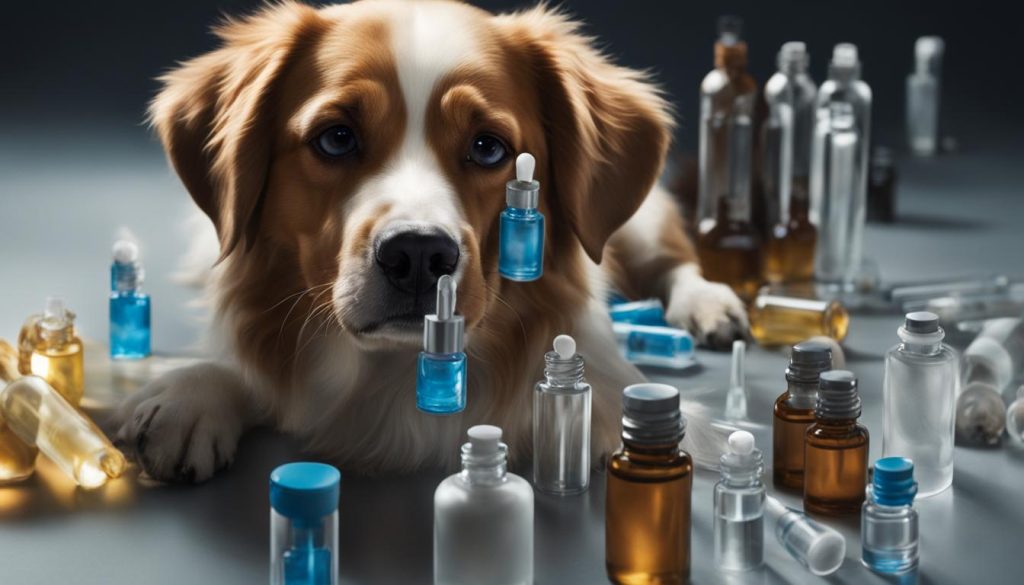
When it comes to treating complex eye conditions in dogs, sometimes a single type of eye drop may not be sufficient. Certain eye issues, such as excessive tearing or epiphora, may require a combination of different eye drops to effectively manage the condition. Combining various types of eye drops can provide a multifaceted approach to treatment, targeting different aspects of the problem. Consulting with a veterinarian is crucial to determine the appropriate combination of eye drops for your dog’s specific needs.
The use of multiple eye drops can be beneficial in addressing different underlying causes of eye problems in dogs. For example, a combination of antihistamine ointments and antibiotic drops may be necessary to manage allergies and prevent infection. In some cases, topical ointments or lubricating drops may also be prescribed to alleviate dryness or discomfort.
It is important to follow the veterinarian’s instructions regarding the timing and frequency of administering multiple eye drops. Each eye drop may have specific guidelines for application, and it is crucial to adhere to these instructions to ensure the safety and effectiveness of the treatment. Additionally, regular check-ups with the vet can help monitor the progress of the treatment and make any necessary adjustments to the combination of eye drops.
Remember, the use of multiple eye drops should always be done under the supervision and guidance of a veterinarian who can tailor the treatment plan to suit your dog’s individual needs. Proper diagnosis, regular follow-ups, and adherence to the prescribed treatment regimen are key factors in maintaining your dog’s eye health.
Table: Example Combination of Eye Drops for Dogs
| Eye Condition | Combination of Eye Drops |
|---|---|
| Allergies |
|
| Conjunctivitis |
|
| Dry eyes |
|
| Inflammation |
|
Selecting the Right Eye Drops for Dogs
When it comes to caring for your dog’s eyes, selecting the right eye drops is crucial. Different types of eye drops serve different purposes, so it’s important to understand which ones are suitable for your dog’s specific eye condition. Here are some key considerations to keep in mind:
- Consult with a veterinarian: Before using any eye drops on your dog, it is always best to consult with a veterinarian. They can examine your dog’s eyes, diagnose any underlying issues, and recommend the appropriate eye drops.
- Types of eye drops: There are various types of eye drops for dogs, including saline eye washes, antibiotic eye drops, steroid eye drops, and lubricating eye drops. Each type serves a different purpose and should be used based on your dog’s specific needs.
- Saline eye washes: Saline eye washes are safe for cleaning debris from your dog’s eyes. They can be especially helpful in removing irritants and soothing minor eye irritations. However, it’s important to choose a sterile eye wash specifically designed for dogs or make your own saline wash at home.
- Prescription eye drops: Certain eye conditions may require prescription eye drops. Antibiotic eye drops are commonly used to treat bacterial infections, while steroid eye drops may be prescribed to reduce inflammation. It’s crucial to use these prescription eye drops only as directed by your veterinarian.
- Follow instructions: When using any eye drops on your dog, it’s essential to carefully follow the instructions provided by your veterinarian or the manufacturer. This includes the correct dosage, frequency of application, and proper technique for administering the eye drops.
Remember, your dog’s eye health is best entrusted to the expertise of a veterinarian. They can guide you in selecting the right eye drops and provide the necessary guidance for proper application. By taking these steps, you can help ensure that your furry friend receives the appropriate care for their eyes.
How to Apply Eye Drops to Your Dog’s Eyes
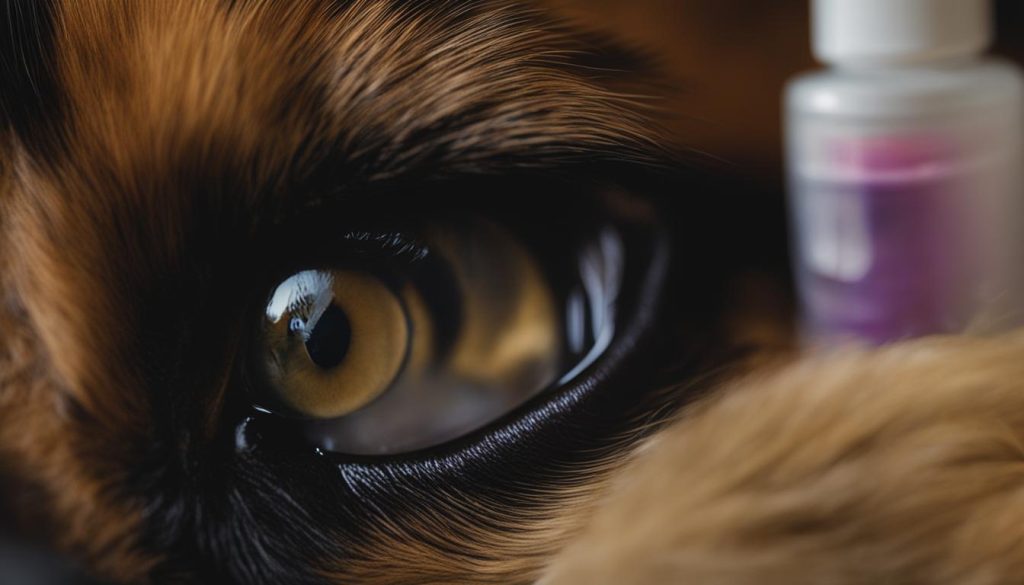
Applying eye drops to your dog’s eyes can be a simple and effective way to administer medication or provide relief for certain eye conditions. However, it is important to approach the process with care and ensure that your dog feels comfortable throughout. Here are some steps to follow when applying eye drops to your dog’s eyes:
- Wash your hands thoroughly to maintain cleanliness and prevent the spread of bacteria.
- Gently clean the area around your dog’s eyes with a warm, wet washcloth to remove any discharge or debris.
- Hold the eye drop bottle in one hand, making sure to keep it clean and avoid touching the dropper tip to prevent contamination.
- Hold your dog’s head steady with your other hand, gently tilting it backward.
- With one hand, gently pull down the lower eyelid to create a small pocket.
- Using your other hand, position the dropper above the eye, just above the lower eyelid.
- Squeeze the prescribed amount of eye drops into the pocket created by the lower eyelid.
- Release the eyelid and allow your dog to blink, which helps to distribute the eye drops evenly across the eye.
- Praise and reward your dog with a treat or kind words to help create a positive association with the eye drop application process.
Remember to always follow the instructions provided by your veterinarian regarding the dosage and frequency of the eye drops. If you’re unsure about the proper technique or have any concerns, don’t hesitate to consult your veterinarian for guidance. By correctly applying eye drops to your dog’s eyes, you can contribute to their eye health and overall well-being.
Pro Tips:
- If your dog is particularly resistant or fearful of the eye drop application process, consider asking a family member or friend to help hold your dog gently but firmly throughout the procedure.
- Some eye drops may need to be refrigerated, so check the instructions provided by your veterinarian and store them properly to maintain their efficacy.
- If you accidentally touch the dropper tip to your dog’s eye or any other surface, replace the bottle to avoid contamination.
| Common Mistakes to Avoid: |
|---|
| Trying to rush the process or being too forceful, which can cause your dog to become anxious or uncooperative. |
| Using expired eye drops or reusing eye drop bottles, as this can compromise the effectiveness of the medication and increase the risk of infection. |
| Administering the eye drops without first seeking a veterinarian’s advice and diagnosis, as some eye conditions may require specific medications or treatments. |
Wrapping Up
When it comes to the question of whether you can use human eye drops on dogs, it is crucial to prioritize your pet’s safety and consult with a veterinarian. While it may be tempting to use these drops as a quick fix, it is essential to understand that human eye drops are formulated specifically for humans and may not be safe for dogs.
Using human eye drops on dogs can potentially cause harm and may not effectively treat the underlying eye condition. Your veterinarian is the best source of guidance when it comes to diagnosing and treating your dog’s eye problems. They have the expertise to examine your dog’s eyes, identify the specific issue, and prescribe the appropriate treatment.
Remember, maintaining your dog’s eye health requires proper diagnosis and treatment, which can only be provided by a qualified veterinarian. It is always better to err on the side of caution and seek professional advice rather than risking your dog’s well-being with unsuitable medications. Your veterinarian will recommend the safest and most effective eye drops for your dog’s specific needs.
So, if you find yourself wondering whether you can use human eye drops on dogs, I encourage you to reach out to your veterinarian. They are your trusted partner in ensuring your dog’s eye health and can provide you with the proper guidance and treatment options necessary for your furry friend.
FAQ
Can You Use Human Eye Drops on Dogs?
Using human eye drops on dogs can be dangerous and may cause major damage to their eyes. Veterinarians must examine and diagnose eye problems in dogs, and medications that work on humans may not have the same effect on dogs. Dog eye infections are common and require proper treatment. Good eye care with dog tear stain removers and eye wipes can help prevent eye problems.
Can Dogs Use Human Eye Drops for Allergies?
Human eye drops, such as Visine, are not safe for dogs and can cause permanent eye damage. Other human antihistamine eye ointments are also unsafe for dogs. Allergies in dogs are usually best treated by identifying and removing the source of the allergy from the dog’s environment.
Can You Use Human Antibiotic Eye Drops for Dogs?
Using human antibiotic eye drops on dogs can be risky as you may not know the type of bacterial infection your dog has. Giving the wrong antibiotic eye drop or the wrong dose can create antibiotic-resistant bacteria and make future infections harder to treat. Dry eyes in dogs may need to be treated with specific eye drops recommended by a veterinarian.
Can You Give Your Dog Human Steroid Eye Drops?
Veterinarians may prescribe dogs with corticosteroids or steroid eye drops for inflammation in the eyes. However, human versions of these eye drops should not be used without consulting a vet, as they can delay healing and have their own risks. The best eye drops for dogs are the ones recommended by a veterinarian after a thorough examination.
Can You Use Human Lubricating Eye Drops for Dogs?
Some human lubricating eye drops may be safe for dogs with temporary dry eye problems. However, it is important to always read the ingredients and consult with a vet before using any human eye drops on dogs. A thorough examination by a veterinarian is necessary to determine the cause of the dry eyes and the best course of treatment.
Can You Use Human Saline Eye Drops on Dogs?
If your dog has a little discharge or needs their eyes rinsed, you can use over-the-counter saline human wash. However, it is important to choose a sterile eye wash specifically designed for dogs or make your own saline wash at home. Always check with a vet before using any eye drops or washes on your dog.
Can I Give My Dog Human Eye Drops for Conjunctivitis?
Ozone-based eye drops have shown to be effective in treating conjunctivitis, keratoconjunctivitis, and corneal ulcers in humans and dogs. However, these eye drops should only be used under the guidance and prescription of a veterinarian. It is important to determine the source of the eye infection through proper testing before using any eye drops on your dog.
When Dogs Need More Than One Kind of Dog Eye Drop
Eye issues in dogs can be complex and may require multiple types of eye drops. Conditions such as excessive tearing or epiphora may need a combination of antihistamine ointments, antibiotics, and other topical ointments. It is important to consult with a veterinarian to determine the proper treatment plan for your dog’s specific eye condition.
Selecting the Right Eye Drops for Dogs
It is crucial to choose the right eye drops for dogs based on their specific eye condition. Saline eye washes are safe for cleaning debris, while antibiotic and steroid eye drops may require a prescription from a veterinarian. It is important to consult with a vet before using any eye drops or medications on your dog’s eyes.
How to Apply Eye Drops to Your Dog’s Eyes
Proper application of eye drops is essential to ensure your dog receives the correct dosage. Wash your hands before and after applying eye drops and use a warm, wet washcloth to clean the area around your dog’s eye. Hold the bottle close to the eye without touching it and squeeze the prescribed amount into the eye. Praise your dog during and after the process to make it easier for both of you.
Wrapping Up
While it may be tempting to use human eye drops on dogs, it is important to consult with a veterinarian before administering any medication. Human eye drops may not be safe for dogs and can potentially cause harm. Proper diagnosis and treatment by a veterinarian are crucial for maintaining your dog’s eye health.


